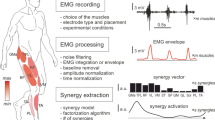Abstract.
Redundancy is associated with the ability of the nervous system to select different interjoint coordinations and movement trajectories to achieve the same motor goal. The nervous system may coordinate multiple degrees of freedom (DF) by combining them in a task-specific way to control them as a unit or synergy. Some movements may be accomplished using only one synergy, whereas other movements may employ several synergies. To investigate the problem of interjoint coordination, we applied principal component (PC) analysis to eight types of movement in healthy male subjects: forward squats, backward squats, sideways squats, squats on one leg, walking three steps, stepping in place, going up a step, and going down a step. Angular changes in four DF were analyzed: thigh flexion-extension, knee flexion-extension, ankle flexion-extension, thigh abduction-adduction, with the former three DF investigated in all movements. For many movements, two synergies were sufficient to account for more than 95% of DF angular excursions. Squatting on one leg could be described using only one synergy (99%). The angle between the vectors representing PCs for movements produced with the right and left legs could be less than 10° for some movements but could reach 25° for other movements. The nervous system may thus use somewhat different interjoint coordinations while producing movements on the right and the left sides. The angle between the first PCs of different movements could be smaller than 10°. Thus there may be a common but adjustable basic synergy that is used to produce different movements. Additional synergies provide the transition from one movement to another.
Similar content being viewed by others
Author information
Authors and Affiliations
Additional information
Electronic Publication
Rights and permissions
About this article
Cite this article
St-Onge, N., Feldman, A.G. Interjoint coordination in lower limbs during different movements in humans. Exp Brain Res 148, 139–149 (2003). https://doi.org/10.1007/s00221-002-1212-8
Received:
Accepted:
Issue Date:
DOI: https://doi.org/10.1007/s00221-002-1212-8




